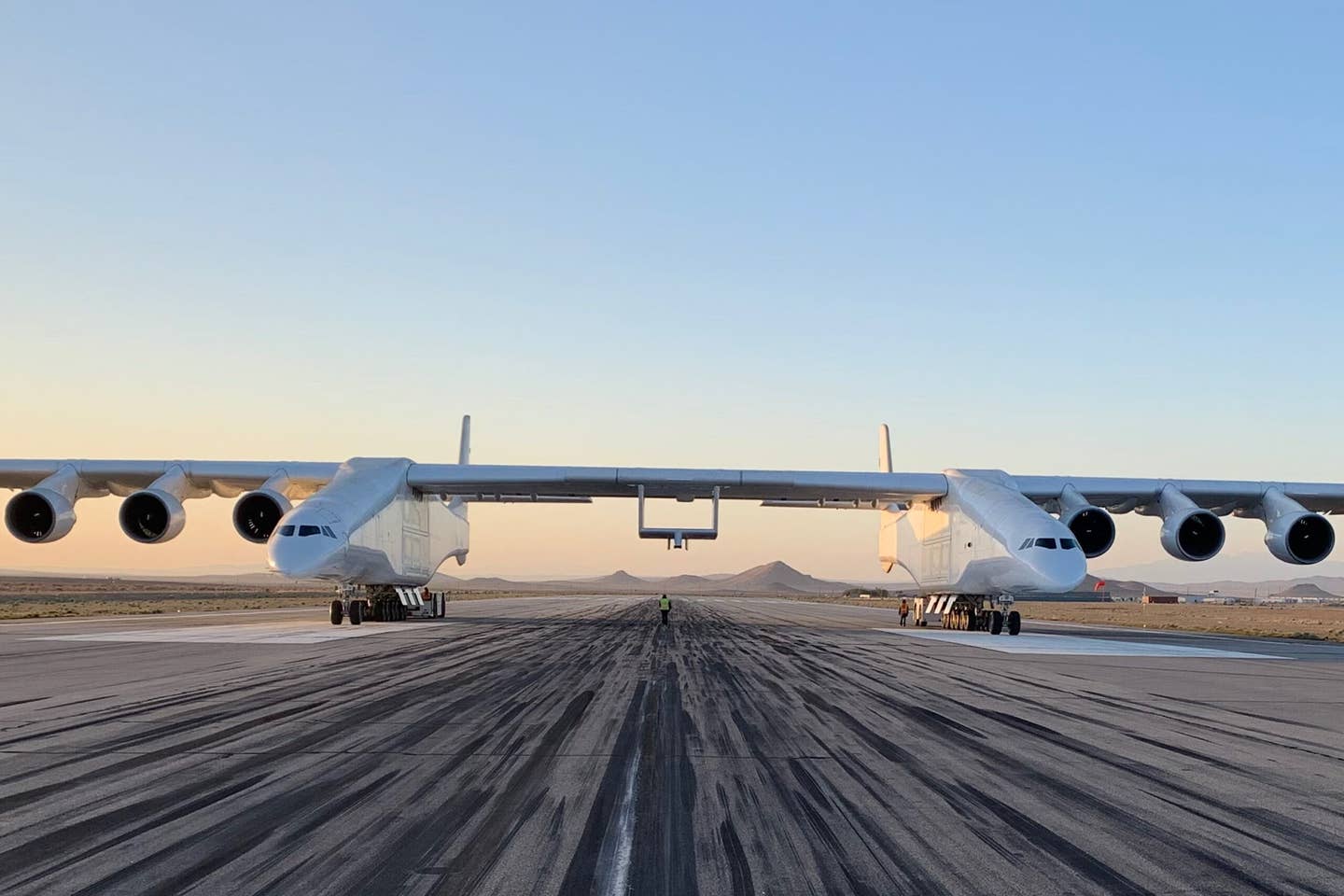The World’s Largest Airplane: By the Numbers
At Stratolaunch’s facility at California’s Mojave Air and Space Port (KMHV), engineers, technicians, and flight crews are preparing the world’s largest airplane for its next test flight. Here are a few key facts and figures highlighting the one-of-a-kind air-to-launch carrier airplane known as Roc.

Stratolaunch’s Roc, the world’s largest airplane by wingspan, now includes a new pylon on its center wing. [Courtesy: Stratolaunch]
At Stratolaunch’s facility at California’s Mojave Air and Space Port (KMHV), engineers, technicians, and flight crews are preparing the world’s largest airplane for its fifth test flight.
Roc, the twin-fuselage behemoth with a wingspan longer than an NFL football field, will have a new piece of equipment on board: a custom pylon attached to the airplane’s center wing.
Don’t be fooled by the pylon’s small profile. It’s key to the success of Roc’s business model—to securely carry and release small, rocket-powered, hypersonic testbeds.
During the upcoming flight, as Roc’s flight engineer and two pilots put the airplane through its paces, experts will be paying close attention to the aerodynamic flow around the pylon and other metrics.
Let’s run down a few numbers that help tell Roc’s story and why it stands alone as a unique wonder of modern science and technology.
1
Roc has one center-wing pylon measuring 15 feet by 15 feet. Eventually, Roc’s pylon will carry and release an uncrewed, automated, Talon-A hypersonic, rocket-powered testbed vehicle at about FL350 (35,000 feet).
2
Roc has two virtually identical fuselages made mostly of carbon composite and separated by a 95-foot center wing.
3
The airplane’s flight crew is made up of three people: two pilots and a flight engineer.
6
Roc’s six powerplants are Pratt & Whitney model PW4056 turbofan engines. They were acquired from retired Boeing 747-400 passenger jetliners. Other parts of Roc that were sourced from retired 747-400s include:
- engine throttles
- windows
- flight deck console
- overhead panel
- controls for generators
- rudder pedals
- yokes
8
The world’s largest airplane needs a total of eight landing gear for takeoff and landing. Two sets of nose gear—one for each nose of Roc’s twin fuselages—and six sets of body gear—three per fuselage—to support the center of the gigantic aircraft. Like Roc’s engines, these landing gear were acquired from retired Boeing 747-400 airliners.
24
With 24 carbon brakes, Roc has “quite a bit of stopping power,” Stratolaunch lead systems engineer Stuart Yun told FLYING. “Each one is capable of absorbing an incredible amount of energy.” When a pilot hits the brake pedals, it activates a cable system connected to a brake metering valve, which supplies a specific amount of hydraulic pressure to the brake stack. Pilots can modulate how much clamping force is applied to each side of the aircraft.
28
The airplane’s 28 wheels help evenly distribute Roc’s titanic load.
50
The Stratolaunch Roc stands 50 feet high.
238
The aircraft measures 238 feet in length. That’s actually short compared to other large airplanes, including the 747-8 and the Lockheed C-5 Galaxy.
351
The airplane was initially named by the company that made it, Scaled Composites, the iconic aviation design and development company founded by aerospace legend Burt Rutan. It was simply called Model 351.
385
This is the number that sets this airplane apart from any other. Those 385 feet—from wingtip to wingtip—are what makes Roc the largest airplane in the world by wingspan. Its wings are wider than Boeing’s 747-8 or Howard Hughes’s mid-century H-4 Hercules—better known as the Spruce Goose. Roc’s wingspan was more than 90 feet wider than the iconic Antonov An-225 Mriya, which was destroyed during Russia’s invasion of Ukraine last February.
500,000
Roc weighs half a million pounds empty. That converts to 250 U.S. tons. Around 15,000 pounds more than the empty weight of a Boeing 747-8.
1.3 Million
It’s rated for a maximum takeoff weight (MTOW) of 1.3 million pounds—very close to the MTOW of the destroyed Antonov An-225 Mriya.

Subscribe to Our Newsletter
Get the latest FLYING stories delivered directly to your inbox






